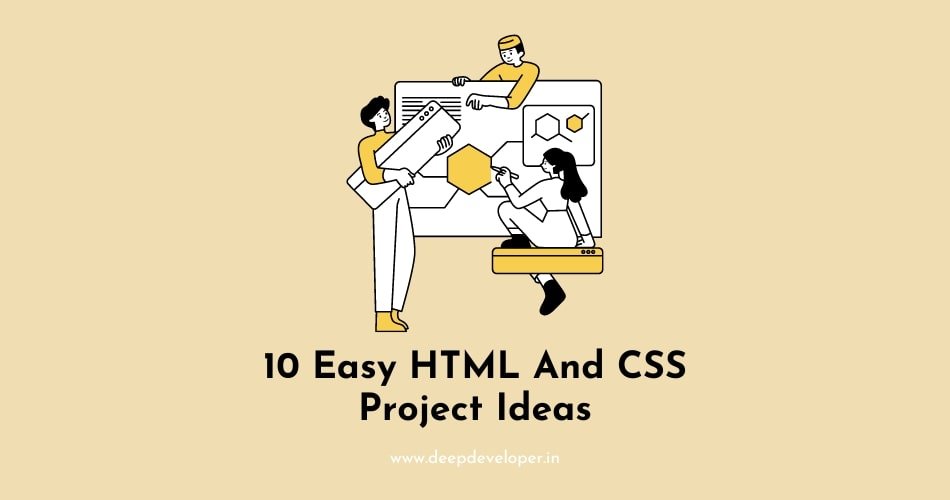As a web developer, it’s essential to have hands-on experience with HTML (Hypertext Markup Language) and CSS (Cascading Style Sheets). These fundamental technologies form the building blocks of web development and are used to create web pages that are visually appealing and interactive. Here are ten exciting HTML and CSS project ideas that you can try to enhance your skills and creativity:
HTML And CSS Project Ideas
#1 Personal Portfolio Website
Create a personal portfolio website to showcase your skills and work as a web developer. You can design a homepage that introduces yourself, a portfolio section with your projects, an about me page, and a contact form. Use HTML to structure the content and CSS to style the layout and design.
#2 Responsive Web Design
Build a responsive web design project that adapts to different screen sizes, such as desktop, tablet, and mobile. You can create a simple website or web page that rearranges and resizes elements based on the screen size using media queries in CSS. This project will help you understand the principles of responsive design and how to make your websites look great on any device.
#3 Product Landing Page
Design a product landing page for a fictional or real product. Include elements like a header, hero section, features section, pricing section, and a contact form. Use HTML to structure the page and CSS to style the layout, colors, and typography to make it visually appealing and professional.
#4 Animated Navbar
Create an animated navbar using HTML and CSS to enhance the user experience of a website. You can add transitions, animations, and hover effects to the navbar elements, such as the logo, links, and dropdown menus. This project will help you learn how to create interactive and visually appealing navigation menus.
#5 CSS Grid Layout
Experiment with CSS Grid Layout, which is a powerful CSS feature for creating complex grid-based layouts. You can create a webpage with a grid of images, cards, or articles. Use CSS Grid to define the layout and align the items in the grid, and CSS to style the design.
#6 Interactive Form
Design an interactive form using HTML and CSS that includes different types of form fields, such as text inputs, checkboxes, radio buttons, and select menus. You can use CSS to style the form elements, add validation, and create custom animations or effects when the user interacts with the form.
#7 Image Gallery
Create an image gallery with a grid of images that expand or display additional information when clicked. Use HTML and CSS to structure the gallery, create thumbnail images, and style the layout and design. You can also add animations or transitions to enhance the user experience.
#8 CSS Animations
Experiment with CSS animations to create visually appealing effects on a webpage. You can create animations for elements like buttons, icons, or images, and use CSS keyframes to define the animation properties, such as duration, timing, and easing. This project will help you learn how to create engaging and interactive web pages using CSS animations.
#9 Pricing Table
Design a pricing table for a subscription-based service or product using HTML and CSS. You can create different pricing tiers with features and pricing details, and use CSS to style the table, buttons, and hover effects. This project will help you learn how to create professional and attractive pricing tables for websites.
#10 Social Media Profile
Design a social media profile page for a fictional or real person or company. Use HTML to structure the profile information, such as profile picture, bio, posts, and followers/following count, and use CSS to style the layout and design. You can also add interactive elements like buttons, hover effects, or animations to make the profile page more engaging.
Also Read:
Final Words
These ten HTML and CSS project ideas are a great way to hone your skills as a web developer and apply what you’ve learned in HTML and CSS to create real-world projects. These projects will allow you to practice creating responsive designs, interactive forms, animated elements, and more, while also improving your understanding of HTML and CSS concepts and best practices.
When working on these projects, remember to follow coding standards, use semantic HTML tags, and keep your CSS organized and modular. You can also experiment with different design styles, color schemes, and typography to showcase your creativity and create visually appealing websites.
Once you complete these projects, don’t forget to showcase them in your portfolio to demonstrate your capabilities to potential employers or clients. Having a diverse range of HTML and CSS projects in your portfolio will greatly enhance your chances of landing web development projects and advancing in your career.

